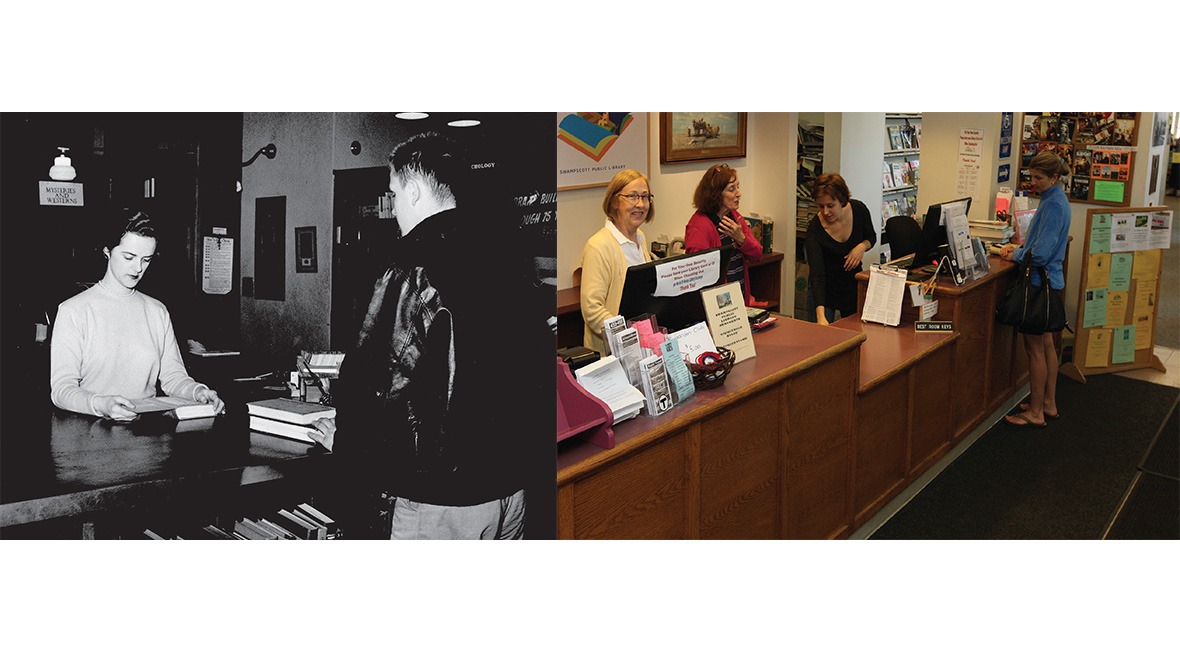Then and now: A librarian helps a visitor to the Swampscott Public Library in the 1950s and, in the photo on the right, longtime directors Susan Conner, left, and Alyce Deveau man the main desk earlier this month.
By DAVID LISCIO
Construction of the Swampscott Public Library, which opened its doors 100 years ago, unveiled an unprecedented world of knowledge and literary entertainment to all town residents.Prior to the library’s construction in 1916 and opening in 1917, the Old Town Hall served as a subscription library to those who could afford it. If you wanted to read, you had to pay.
That all changed when wealthy Swampscott resident Elihu Thomson, a British-born American engineer and inventor, donated his tennis court to the town.
Thomson lived in the Monument Avenue mansion that now serves as Swampscott Town Hall. The tennis court, directly behind it and abutting Burrill Street, was large enough to accommodate a public library building.

The Boston design firm Kelley and Graves was hired for the task, specifically architects James T. Kelley and Harold S. Graves. The firm previously designed the Peter Faneuil School at 60 Joy St. in Boston in 1910 and other prominent buildings.
By then, Thomson and a partner had founded Thomson-Houston Electric Co., a business based on their inventions that included a magnetic lightning arrester. In 1892, the company merged with Edison General Electric Co., formed by infamous inventor Thomas Edison, to become the General Electric Co.
World War I was still raging in Europe when the public library held its grand opening. A look back at reader preferences in 1917 showed an appetite for serial books, not unlike today. Among the most popular titles was The Lost Princess of Oz, the eleventh of the so-called Oz books by L. Frank Baum. Other top titles that year included Summer by Edith Wharton, Introductory Lectures on Psychoanalysis by Sigmund Freud, and Anne’s House of Dreams, the latter book No. 5 in the Anne of Green Gables series.
Libraries owned far fewer titles in the early 1900s, given the limits of publishing houses and overall affordability. The world of self-publishing turned that situation on end, giving librarians almost limitless choices on how to stock their shelves.
Today, Swampscott Public Library has 110,000 books in its collection, and another 56,000 videos, ebooks and magazines. There are 15 public Internet terminals and an array of printers and scanners for public use.
“We have lots of children and adults who come here because they’re out of ink at home and need to use our printers,” said Library Director Alyce Deveau, who has worked at the library for 35 years. “Things are a lot different from when I first started here part-time.”
A former English teacher at Pickering Middle School and Classical High School in Lynn, Deveau has witnessed the dramatic changes in how information is packaged and delivered to the public.
“The wooden card catalogs are long gone,” she said, noting the system required three cards be filed in different drawers for each book since they were separately referenced by title, author name and shelf number. The three systems made it easier to locate each volume. “We had to make room for the computer equipment.”
The library began offering ebooks about five years ago, which are available to Swampscott residents through the North of Boston Library Exchange (NOBLE) network. Members can read ebooks sent directly to their Kindle or other mobile reading device.
The library also features a digital heritage collection of photographs, which appeals to history buffs.
Susan Conner, the library’s assistant director and a staffer for 32 years, said most of the reference books were also discarded to increase space. “The almanacs, the dictionaries, the encyclopedias have all been replaced by online versions,” she said.
Each year, as book tastes and titles change, the librarians research industry publications like BookList, Library Journal and the School Library Journal as they decide how to replenish the collection. They must also weed out the books no longer in demand, those that have become outdated, or are lacking in literary value.
“No more Patterson,” quipped Deveau, alluding to popular American writer James Patterson who releases a new book just about every month, often with a co-author.
Local history books remain on the shelves because of their cultural significance. Each month, a group of history buffs gathers at the library to discuss the town’s past.
During a recent Friday morning meeting led by Lou Gallo, the town’s unofficial historian, talk was focused on the former wooden toboggan run at Jackson Park.
“We have lots of groups that meet here,” said Deveau. “The library is really a cultural center.”
According to Conner, the library had 72,552 people come through the front door in 2016. Many of them were schoolchildren. “We have classes that come in, and parents bring their kids for story time. We also run an author program where authors come a speak about their books, and a couple of writers’ group.”
The library hosts the Needlers knitting group. There’s also a brunch club designed for stay-at-home moms who can stop by to join the book discussion group while their children are at school, or are perhaps young enough to accompany them to the library play area where pizza is often available.
“It’s an alternate community center for some of these moms. A brunch is the only time they can join a book group because they’re home at night with the kids,” Deveau said.
The library has two part-time children’s librarians who oversee the story time sessions, and a special room is designated for this purpose.
The centennial celebration was kicked off in January and has continued throughout the year with a variety of events, including a special appearance by Lauren Baker, wife of Gov. Charlie Baker.
The state’s first lady, who with her husband lives on Monument Avenue diagonally across the street from the library, took part in a January panel discussion and read a book to a group of about 30 toddlers.
“Literacy is important for all of our children,” said Baker, whose children grew up in town and often visited the library. “I’ll do anything I can do to help improve literacy across the state. It’s pretty clear reading often to children is beneficial to their development. I’ll go as often as I can to read in schools and libraries.”
Baker read from Froggy Goes to the Library by Jonathan London, the tale of a young frog who pushes a wheelbarrow to the library in order to carry home all the books he plans to read.
In March, Baker joined the children’s pajama party at Swampscott library where she read A Bed for Every Bear: Tuck’s Tale, written by local author Stacey Marcus and illustrated by children statewide.
Swampscott Historical Commission member Sylvia Belkin joined the celebratory discussion, offering perspective on the town’s past and the role of the library in the community.
The town has had a library since 1853, when the Board of Selectmen favored a proposal by Boston resident Lawrence Williams who donated $100 and 66 books to seed the project. It operated as a subscription library until 1879. Books from that library were added to the public collection when the present library opened 100 years ago.
David Liscio is a photojournalist from Nahant and a frequent contributor to 01907 Magazine. www.davidliscio.com

